What Type Of Mammal Can Be Found In A General Garden Environment.
Plants and animals are not distributed randomly or evenly over the landscape. Each organism lives in an environment which best provides the food, water, air, temperature and other needs of that organism. The climate, geology and topography of any spot on Earth are the chief factors which determine these environments. The species of animals and plants that live in a particular area also are greatly affected by the intensity, frequency and recency of natural disturbances and human activity.
The Nature Reserve, with about 2500 acres situated on the northern edge of the Ozarks, has a great diversity of plant and animal communities. This diversity is due to its geologic history, the inclusion within its boundaries of two miles of the Meramec River and its tributary, Brush Creek, and earlier and current human activity. The communities found on the Reserve are:

Chanterelles (Cantharellus cibarius) can be found in rich forest soil
Woodland and Forest
Areas dominated by trees form the greatest area of habitat on the uplands of Shaw Nature Reserve. Several oak and hickory tree species, in various combinations, characterize these habitats. The northern part of Shaw Nature Reserve north of the Trail House has rolling hills, broad valleys and deep soil. It is similar to the landscape north of the Missouri River. The area between the Trail House and the Meramec River has steeper hills and ridges with shallower soils, narrow valleys and numerous intermittent rivulets. It is more similar to the terrain of the Ozarks. This area of steeper topography may also be called an Ozark Upland Forest. The greater relief in this area is due to the erosive action of the Meramec River during the past 2.5 million years. Many species of plants and animals characteristic of the Ozarks are found here. The ridges and upper slopes of this area have thinner, rockier soil and support different species of trees and herbaceous plants than the lower slopes and valleys with their richer soil. Bedrock and bluffs exposed in the upland forest are of the Ordovician Period, about 450 million years old.
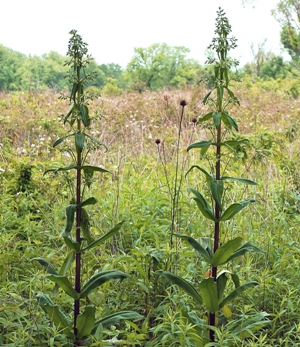
Frasera caroliniensis, commonly known as American columbo or yellow gentian, is a herbaceous monocarpic perennial of the gentian family
White-tailed deer (Odocoileus virginianus), and gray and fox squirrels (Sciurus caroliniensis and S. niger) are common mammals of the upland forest, and our largest bird, the wild turkey (Meleagris gallopavo) is also, since an important part of their diet is acorns and hickory nuts. Woodchuck (Marmota monax) and cottontail rabbit (Sylvilagus floridanus) are found in the border area of woods and meadows. Raccoons (Procyon lotor), opossums (Didelphis virginiana) and striped skunk (Mephitis mephitis) are also members of this community, but are seldom seen because of their nocturnal habits. Red and gray fox are uncommon at Shaw Nature Reserve, where coyote and bobcat are the top predators. The varied topography and great diversity of trees, spring wildflowers, and animal life make this area popular with both the serious nature student and those who enjoy an outing in a beautiful and quiet natural area. The upland forest is especially beautiful from March to June, with a succession of wildflowers blooming in varied habitats. Management activities including invasive species removal and prescribed burning have resulted in more airy and better lighted woodlands, yielding a longer and more diversified season of wildflower, insect and bird activity.
More about woodlands at Shaw Nature Reserve
Bottomland Forest
In geological terms, the flood plain is a youthful area in a state of constant change. The river bed is slowly moving southward, creating on the north bank a series of ridges and troughs which are a visible record of the gradual change in the river's course. Bottomland forest at Shaw Nature Reserve is best represented by the tall timbers in the flood plain of the Meramec River. Characteristic trees in this area are sycamore (Platanus occidentalis), cottonwood (Populus deltoides), silver maple (Acer saccharinum), slippery elm (Ulmus rubra), green ash (Fraxinus pennsylvanica) and box elder (Acer negundo). But even this giant forest is mostly under 100 years old, having grown up since the 1920s, when it ceased to be farmed. These species need bare soil for their seeds to germinate. The frequent flooding of the Meramec provides this bare soil by washing leaves away and depositing a layer of silt as the flood water recedes. The Meramec River Bottomland Forest State Natural Area is an area of old growth forest within this younger forest, never farmed, and dominated by large specimens of bur oak (Quercus macrocarpa), pin oak (Quercus palustris) and shellbark hickory (Carya laciniosa). The deep alluvial soil provides adequate moisture for tree growth even in the driest years, resulting in a fast-growing forest of immense trees.
Masses of bluebells (Mertensia virginica), trout lily (Erythronium albidum), wood phlox (Phlox divaricata) and false rue anemone (Isopyrum biternatum) make spectacular displays here in spring. During the spring migration, many neotropical migrant birds may be heard and observed in the treetops, as they fuel themselves for continued travel north on the caterpillars and other insects that eat the fresh foliage of the trees. Some of these, such as the indigo bunting (Passerina cyanea), northern parula (Parula americana) and prothonotary warbler ( Protonotaria citrea) stay on to breed in this magnificent forest. Several woodpecker species, including our largest, the pileated woodpecker (Dryocopus pileatus), are year-round residents.
More about bottomland forests at Shaw Nature Reserve
Glade
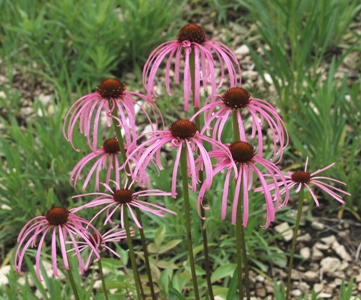
Glade purple coneflower (Echinacea simulata) thrives in full sun and thin glade soils.
The dolomite glade is a community of plants and animals that is characteristic of the Ozarks and other old eastern US hill ranges. Glades are grassy, flowery openings occurring within upland woods, on outcrops of dolomite bedrock, on south- and west-facing slopes. The combination of shallow soil and direction of slope produces a hot, often extremely dry environment, with shallow, gravelly soil which inhibits rapid growth of trees. Birdsfoot violet (Viola pedatifida), Indian paintbrush (Castilleja coccinea), Missouri evening primrose (Oenothera macrocarpa), the rare Fremont's leather flower (Clematis fremontii), lance-leaf tickseed (Coreopsis lanceolata) and glade purple coneflower (Echinacea simulata) bloom in waves of color from April to early July. Animals typical of drier and hotter habitats to the west, the six-lined racerunner lizard (Cnemidophorus sexlineatus), the plains scorpion (Centruroides vittatus) and the New Mexico tarantula (Aphonopelma hentzi) are occasionally seen on Shaw Nature Reserve glades. Usually present only in low numbers, every few years, the gorgone checkerspot butterfly (Chlosyne gorgone) emerges in great numbers in the glades.
More about glades at Shaw Nature Reserve
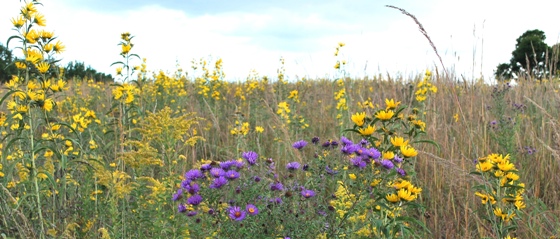
Tallgrass Prairie
 Prairie is an ecosystem dominated by grasses and wildflowers with few trees or shrubs. Grasslands once covered the central 1/3 of the US and southern Canada west to the base of the Rocky Mountains, and the humid tallgrass prairie occupied about the eastern third of this area. Prairie plants, with roots penetrating to 10 or 15 feet, are adapted to the midsummer droughts of this region. The Nature Reserve's 250-acre prairie is a reconstructed ecosystem, established on former farmland to represent this once-vast ecosystem where innumerable American bison (Bison bison) and elk (Cervus canadensis) once roamed. These two large mammals are effectively extinct as wild populations in Missouri.
Prairie is an ecosystem dominated by grasses and wildflowers with few trees or shrubs. Grasslands once covered the central 1/3 of the US and southern Canada west to the base of the Rocky Mountains, and the humid tallgrass prairie occupied about the eastern third of this area. Prairie plants, with roots penetrating to 10 or 15 feet, are adapted to the midsummer droughts of this region. The Nature Reserve's 250-acre prairie is a reconstructed ecosystem, established on former farmland to represent this once-vast ecosystem where innumerable American bison (Bison bison) and elk (Cervus canadensis) once roamed. These two large mammals are effectively extinct as wild populations in Missouri.
Prairie plants are introduced by direct seeding and greenhouse-grown transplants. The tall grasses, reaching over our heads, remind us of the ocean as they wave in a gentle breeze. Over 100 species of wildflowers bloom in the prairie beginning in late April and ending in October. The leaves, stalks, and blossoms of these wildflowers present a fascinating variety of colors, shapes, and textures. Some species, such as goldenrod and sunflower (Solidago and Helianthusspecies), spread across the prairie in cheery yellow masses.
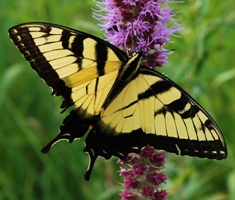 The Reserve's prairie has moderate to gentle slopes and for the most part, deep fertile soil. The low areas near Brush Creek and in the Wetlands Area contains many species of plants found in wet prairies. An observation deck on the highest elevation provides a sweeping view of the multicolored prairie and the surrounding rolling hills. From here one can picture the pioneer wagons winding through the tall grasses on their way to settle the new land.
The Reserve's prairie has moderate to gentle slopes and for the most part, deep fertile soil. The low areas near Brush Creek and in the Wetlands Area contains many species of plants found in wet prairies. An observation deck on the highest elevation provides a sweeping view of the multicolored prairie and the surrounding rolling hills. From here one can picture the pioneer wagons winding through the tall grasses on their way to settle the new land.
More about prairies at Shaw Nature Reserve
River Community
The River Community is composed of the Meramec River, gravel bars and streams. Three miles of the Meramec River flow through Shaw Nature Reserve. Geologically the Meramec, like other Ozark rivers, is classified as an entrenched meander meaning it has been downcutting through the ancient Ozark rocks since the last uplift about 1 million years ago. This downcutting produced the spectacular bluffs and steep hills and valleys in the southern half of the Nature Reserve. The gradient of the river through the Nature Reserve is gentle enough for pleasant canoeing with stretches of faster water to make it interesting.
The Meramec is host to a great variety of fish, turtles, and a healthy diversity of freshwater mussels. Green herons, great blue herons, and bank swallows are often seen by hikers and canoeists along the river. Muskrat (Ondatra zibethica) and beaver (Castor canadensis) live here and their tracks and those of raccoon (Procyon lotor) and deer (Odocoileus virginianus) are common in the mud along the river. Increasingly in recent years, the America bald eagle (Haliaeetus leucocephalus) has nested in the groves of large trees lining the Meramec.
Stream
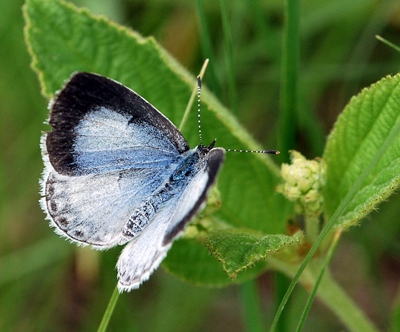 A number of streams flow through Shaw Nature Reserve. All are intermittent except Brush Creek, which flows from west to east in the northern half of the Reserve. These stream bottoms are a good place to study the exposed rock strata and the erosion and deposition of soil and rock. Species of plants requiring moist conditions or good drainage are found along the stream and stream bank. Brush Creek has well-drained but reliably moist banks where shingle oak (Quercus imbricaria), walnut (Juglans nigra), paw-paw (Asimina triloba) and wild black cherry (Prunus serotina) trees grow in addition to the bottomland species. In recent years, the banks of Brush Creek have been invaded by the invasive shrubs Amur honeysuckle (Lonicera maackii) and border privet (Ligustrum obtusifolium)have formed dense thickets. The ecological restoration team has ramped up control efforts and volunteers are playing a critical role in improving the health of our natural areas.
A number of streams flow through Shaw Nature Reserve. All are intermittent except Brush Creek, which flows from west to east in the northern half of the Reserve. These stream bottoms are a good place to study the exposed rock strata and the erosion and deposition of soil and rock. Species of plants requiring moist conditions or good drainage are found along the stream and stream bank. Brush Creek has well-drained but reliably moist banks where shingle oak (Quercus imbricaria), walnut (Juglans nigra), paw-paw (Asimina triloba) and wild black cherry (Prunus serotina) trees grow in addition to the bottomland species. In recent years, the banks of Brush Creek have been invaded by the invasive shrubs Amur honeysuckle (Lonicera maackii) and border privet (Ligustrum obtusifolium)have formed dense thickets. The ecological restoration team has ramped up control efforts and volunteers are playing a critical role in improving the health of our natural areas.
Children have a universal fascination with creeks. Here they may explore the strange world of stream cobbles and invertebrate life in all seasons among the fallen trees, exposed roots, overhanging shrubbery and gurgling water.
Gravel Bar
Several large gravel bars are located on the three-mile stretch of the Meramec River which flows through Shaw Nature Reserve. The shape and size of these gravel bars are constantly changed by the powerful force of flood waters. Annual plants and trees spring up from seeds left by the receding water. Their roots stabilize the new deposits of silt and gravel. Later floods tear out most of the young sycamore and silver maple, but the deeper rooted willows hang on. Eventually, the course of the river shifts, and gravel and silt stabilized by these pioneer trees becomes covered with flood plain forest.
People of all ages enjoy exploring the gravel bars. Here is an endless variety of chert, sandstone, and limestone rocks, piles of driftwood, animal tracks, frogs by the hundreds and the sight and sound of swift, free-flowing, clear water.
More about the river community at Shaw Nature Reserve

Wood ducklings (Aix sponsa) float among water lilies (Nymphaea tuberosa)
Pond
Numerous ponds are scattered throughout the grounds of Shaw Nature Reserve, the most prominent of them being Pinetum Lake near the main entrance. Numerous shallow ponds occur near the Wetland Trail and Brush Creek Trail. Most are unnamed, but are indicated on the Shaw Nature Reserve map. These are among the more interesting ponds, because they were seeded with diverse wetland plants shortly after construction, and the lack of fish in most of them allows a much greater diversity of insects and amphibians to occupy them, relative to the older, fish-inhabited ponds.
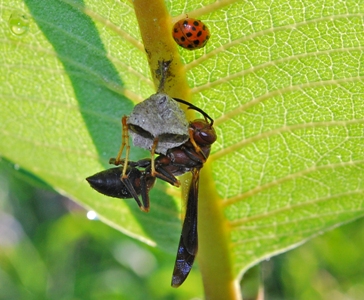 Shaw Nature Reserve also has four older and deeper ponds. Wolf Run Lake, the largest of the four, is a tranquil resting place near the end point of Wolf Run Trail. Second-growth forest, once cut-over for farming, frame the lake and are mirrored in the water. Broad-leaved cattail grows in areas around the pond, a factor in natural pond succession. Animals and birds are attracted to the lakeside. The water abounds with frogs, turtles, fish, snakes and insects.
Shaw Nature Reserve also has four older and deeper ponds. Wolf Run Lake, the largest of the four, is a tranquil resting place near the end point of Wolf Run Trail. Second-growth forest, once cut-over for farming, frame the lake and are mirrored in the water. Broad-leaved cattail grows in areas around the pond, a factor in natural pond succession. Animals and birds are attracted to the lakeside. The water abounds with frogs, turtles, fish, snakes and insects.
Pot-Hole Lake, located near the north and lower boundary of the Tallgrass Prairie, enhances the view from the prairie hilltop and is an interesting community of itself. Fish and pond life can be observed; a variety of vertebrate and invertebrate animal life is also attracted to the water.
Mirror Lake is a small, round pond, set in the rolling meadows, north and east of the Trail House. This pond lies over a sinkhole—a collapsed cavern—and some day may be swallowed up by further geologic processes below.
Few visitors see Wood Duck Lake but it is a small, secluded pond of great charm, tucked away near the East Bridge. Bald cypress trees grow on a small island and many species of birds find the area attractive.
More about ponds at Shaw Nature Reseve
Pinetum
The first area that visitors see at Shaw Nature Reserve is the Pinetum, a collection of maturing native oaks and conifers around a three-acre lake. The conifers were planted in the 1930s including bald cypress (Taxodium distichum) and eastern white pine (Pinus strobus) grouped to form pleasant vistas throughout the rolling landscape. In spring, thousands of daffodils (Narcissus, various cultivars and hybrids) bloom throughout the Pinetum meadows, to be followed by ox-eye daisies (Leucanthemum vulgare), butterfly weed (Asclepias tuberosa) and wild petunia (Ruellia strepens).
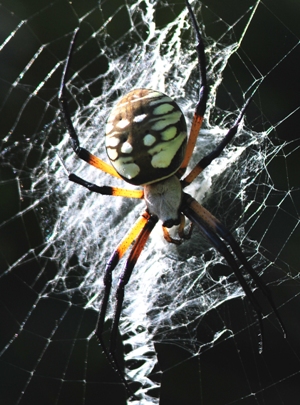 Many species of birds are attracted by the conifers, as well as gray and fox squirrels. White winged crossbill (Loxia leucoptera) is a boreal forest bird that may be found in the Pinetum's conifers during some winters. A profusion of insects inhabit the meadows. Pinetum Lake teems with several species of frogs, fish, turtles, water snakes, crayfish and minute and microscopic water life, and is often a stopover for small numbers of migratory waterfowl in spring.
Many species of birds are attracted by the conifers, as well as gray and fox squirrels. White winged crossbill (Loxia leucoptera) is a boreal forest bird that may be found in the Pinetum's conifers during some winters. A profusion of insects inhabit the meadows. Pinetum Lake teems with several species of frogs, fish, turtles, water snakes, crayfish and minute and microscopic water life, and is often a stopover for small numbers of migratory waterfowl in spring.
In recent years, the planted conifers have been in declining health and are dying off. Shaw Nature Reserve manages this area with a combination of mowing, prescribed fire, native seed addition and invasive species control to allow the area to evolve toward a more natural landscape. We have allowed post oak and other native trees to grow up in a widely spaced array, and started to control the rampant growth of invasive honeysuckles (Lonicera maackii and L. japonica), privet (Ligustrum obtusifolium) and wintercreeper (Euonymus hederaceus), resulting in the early stages of development of a post oak savanna and marshy pond margin. The Nature Explore Classroom ™ , an educational outdoor play area near the visitor center, is landscaped extensively with native plants in a setting partially shaded by eastern white pines (Pinus strobus).
More about the Pinetum at Shaw Nature Reserve
The South Side
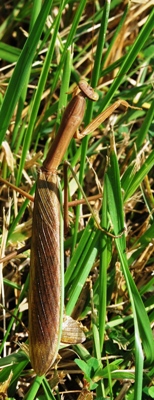 Six hundred and thirty acres of Shaw Nature Reserve lies south of the Meramec River. Part of this land is leased by a cattle farmer, whose herd management involves a low stocking rate and frequent rotation of the cows among multiple paddocks. This keeps any single enclosure from being overgrazed, and allows for varied height and structure of vegetation which attracts birds like Eastern meadowlarks. Another section in the Meramec River 100-year floodplain was used to grow corn and soybeans over the years, but was converted to a 40-acre wetland mitigation surrounded by native grassland buffer. Adjacent to the farmland are an additional 250 acres of woodland, in several large patches, including the Meramec Bottomland State Natural Area. This mature, oak-dominated bottomland forest is considered the best example of its kind in the lower Meramec River Valley. It includes an oxbow slough that is the season hang-out of dozens of wood ducks (Aix sponsa), which gather there to gorge on acorns of pin and shingle oak (Quercus palustris and Q. imbiricaria) acorns that overhang this crescent of water. Coyotes (Canis latrans), which live along the adjacent river, are seen seeking prey in the fields, as are flocks of foraging turkeys (Meleagris gallapavo). This area is not open to the public.
Six hundred and thirty acres of Shaw Nature Reserve lies south of the Meramec River. Part of this land is leased by a cattle farmer, whose herd management involves a low stocking rate and frequent rotation of the cows among multiple paddocks. This keeps any single enclosure from being overgrazed, and allows for varied height and structure of vegetation which attracts birds like Eastern meadowlarks. Another section in the Meramec River 100-year floodplain was used to grow corn and soybeans over the years, but was converted to a 40-acre wetland mitigation surrounded by native grassland buffer. Adjacent to the farmland are an additional 250 acres of woodland, in several large patches, including the Meramec Bottomland State Natural Area. This mature, oak-dominated bottomland forest is considered the best example of its kind in the lower Meramec River Valley. It includes an oxbow slough that is the season hang-out of dozens of wood ducks (Aix sponsa), which gather there to gorge on acorns of pin and shingle oak (Quercus palustris and Q. imbiricaria) acorns that overhang this crescent of water. Coyotes (Canis latrans), which live along the adjacent river, are seen seeking prey in the fields, as are flocks of foraging turkeys (Meleagris gallapavo). This area is not open to the public.
This property, with its grazing cattle and open spaces, presents a pastoral scene to visitors at the overlook across the Meramec. The north and west edge of the farmland adjoins the Meramec River, giving the Reserve control of both sides of 1.5 miles of the river.
What Type Of Mammal Can Be Found In A General Garden Environment.
Source: https://www.missouribotanicalgarden.org/visit/family-of-attractions/shaw-nature-reserve/conservation-at-shaw-nature-reserve/plants-animals-habitats.aspx
Posted by: knightllostastings.blogspot.com

0 Response to "What Type Of Mammal Can Be Found In A General Garden Environment."
Post a Comment